The Fuzzy Story by Fred Patten
Original version published in Fur Scene #5, Winter 1995, pages 17-23. Revised version published in Anthro #14, November-December 2007. Re-revised version sent to John F. Carr, July 2011.
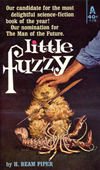
One of the trickiest jobs of an SF author is to create an alien species that has enough affinity with mankind to be charismatic to readers rather than merely exotic, yet is not so humanoid as to seem like ordinary people in cheap makeup. One of the most successful is (are?) the Fuzzies of the planet Zarathustra, created by H. Beam Piper in his novel Little Fuzzy.
The "high concept" description of the Fuzzies was that they were like howler or capuchin monkeys, but with longer, silkier fur; much friendlier and more charismatic. They roamed the forests of Zarathustra, a recently settled and still partially-unexplored extrasolar planet. They lived off fruits and Zarathustra's land crustaceans, in small social groups rather like chimpanzees. But they seemed smarter than any Earth monkeys. Were they smart enough to be legally classified as intelligent beings? That was the central question in Little Fuzzy.
SF fans wanted more Fuzzy stories. They got them, but unfortunately they came muddled with confusion and tragedy. By the time that the last of them was published, most Fuzzy fans were so bewildered as to the "true" Fuzzy story that there was general agreement that the series should be laid to rest.
How confused was it? The Encyclopedia of Science Fiction and Fantasy, comp. by Donald H. Tuck (Advent, 1978); The Encyclopedia of Science Fiction, ed. by Peter Nicholls (Granada Publishing, 1979)); Dictionary of Literary Biography. V.8. Twentieth-Century American Science Fiction Writers. Pt.2, M-Z, ed. by David Cowart and Thomas L. Wymer (Gale Research Co., 1981); and Twentieth-Century Science-Fiction Writers, 3rd Edition, ed. by Noelle Watson and Paul E. Schellinger (St. James Press, 1991) – all reputable reference books – give Piper's full name as Henry Beam Piper and the date of his death as November 11, 1964. But Federation, a collection of some of Piper's short stories published by Ace Books in February 1981, contains an introduction by Piper collector and expert John F. Carr giving his full name as Horace Beam Piper, and going into some detail of his death on November 9, 1964. The Library of Congress and most public library cataloging systems based upon LC's also list Horace as Piper's first name.
Carr stated in that 1981 Federation introduction, "And when the third Fuzzy novel, Fuzzies and Other People, was rejected by Avon as being too dependent upon the other books in the series, he felt his career had come to an end. (The third Fuzzy novel has since become lost and is the property of the Piper estate now owned by Ace Books. Anyone aiding in its recovery will be amply rewarded)". Yet when Locus reported the discovery of the missing novel in its October 1982 issue, its story said that right up until the moment that the manuscript was found in July by "Michael Knerr, a close friend of Piper's who had in his possession all of Piper's notebooks", Knerr had been assuring everybody that Piper had only written two Fuzzy novels and that the story of a third, lost manuscript was just wishful dreaming by the Fuzzy fans. That same Locus report gave the reason for Avon's rejection of the third novel as that "the second book didn't sell", not that it was too dependent on the other books in the series. (That had been the reason given by Frederik Pohl for rejecting it as a serial for Galaxy or Worlds of If magazines). So it seemed that even Piper's closest friends and fans were confused over the complete Fuzzy story at the time. (However, see the Afterword.)
H. Beam Piper was a popular SF writer of the 1950s and 1960s. It was common at this time for SF authors to loosely tie their novels and magazine short stories together in a "future history". Piper followed suit. His future history was so casual that it did not have a name (at that time; later named the Terro-Human Future History series by his fans), but many of his interstellar stories were set in a galactic civilization tied together by a common timeline. Several planets of various stars were mentioned, named by human space explorers after mythological or literary references such as Marduk, Uller, Loki, Poictesme, Zarathustra. The separate stories took place on different worlds, with only casual mentions of the others and to a galactic government (originally a Terran Federation which eventually collapsed and was replaced by a Galactic Empire) to link them together.
Piper was a regular attendee of the World Science Fiction Conventions, and he maintained a correspondence with several of his fans. During 1961, it was reported that Piper had just finished a new novel set during the Terran Federation period of his future history, on his as-yet-unused planet Zarathustra.
That story was Little Fuzzy, published as an original paperback novel by Avon Books in January 1962. Little Fuzzy was an immediate hit, more popular than anything else Piper had written before. The front-cover blurb said (either by happenstance or as subliminal suggestion), Our Candidate for the Most Delightful Science-Fiction Book of the Year! Sure enough, as soon as the Hugo nominations opened for the best SF novel of 1962, Little Fuzzy got enough votes for Best Novel to appear on the final ballot. (It lost to Philip K. Dick's The Man in the High Castle; understandably heavyweight competition).
Its original back-cover blurb still provides its best summary:
Friends of Little Fuzzy Vs. the Chartered Zarathustra Company
The chartered Zarathustra Company had it all their way. Their charter was for a Class-III uninhabited planet, which Zarathustra was, and it meant they owned the planet, lock, stock and barrel. They exploited it, developed it, and reaped the huge profits from it without interference from the Colonial Government.
Then Jack Holloway, a sunstone prospector, appeared on the scene with his family of Fuzzies and the passionate conviction that they were not cute animals but little people.
The Company was aghast at this threat to their power and profits. If Holloway could prove the Fuzzies were people, Zarathustra would automatically become a Class-IV inhabited planet, the Company's charter would become void and the Colonial Government of the Federation would take over.
The Company did not hesitate to resort to coercion, murder – even genocide – to prevent the Fuzzies from being declared the ninth extrasolar sapient race.
Little Fuzzy was both a courtroom and a scientific melodrama. Where is the legal dividing line between clever animals which are still "only animals", and beings intelligent enough to be considered people with all pertinent rights and obligations? Where is the scientific dividing line between sapience and non-sapience? Piper had carefully worked out a scenario that kept the Fuzzies seemingly right on the borderline for most of the story, then revealed them at the climax to be fully intelligent, in a manner that seemed natural and not overly manipulative.
Little Fuzzy ended with the Zarathustra Company's power broken, Fuzzies' legal rights guaranteed, and several individual Fuzzies established as popular characters. However, the ending set up a large question as to how both humans and Fuzzies would get along together under the totally new political situation on Zarathustra. Piper's fans demanded a sequel. In June 1963, Avon authorized Piper to write two more Fuzzy novels, thanks to the sales of the first novel and to its Hugo nomination. Piper told his fans that the first would be Fuzzy Sapiens, due out in January 1964. The second would be Fuzzies and Other People, due out maybe a year after that.
(It should be pointed out that Piper was not dealing directly with Avon. His stories were handled through his literary agent and friend, Ken White. In fact, Little Fuzzy was dedicated:
TO KENNETH S. WHITE Who helped Little Fuzzy find a home in print
So Piper's news to his fans was actually second-hand, based upon what White was reporting to him.)
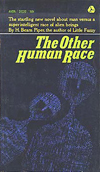
Unfortunately, the editor who bought the Fuzzy novels then left Avon, and was replaced by a new editor who was hostile to the Fuzzies. No reason was ever given. Incompetence? A new employee trying to sweep away his predecessor's projects? In any case, the new editor inadvertently or deliberately sabotaged Piper. Fuzzy Sapiens was not published in January 1964 as originally scheduled. Piper told his fans that Avon would not give any reason for the delay. Then in June 1964 it was released with no publicity under a different title, The Other Human Race, with a blurb about "man versus a super intelligent race of alien beings" which made the Fuzzies sound like conquering aliens trying to take over the galaxy. The cover illustration was a dark blue surrealistic line drawing against a black background which made it look solid black with no art at first glance. Many fans who were waiting for the sequel to Little Fuzzy did not realize that this was it; Piper and White themselves only learned about its publication when friends mentioned it in correspondence. The packaging certainly did not attract readers. Sales were dismal, and the Avon editor promptly rejected the third novel on the grounds that the poor sales of The Other Human Race proved that it had been a mistake to accept the Fuzzy novels.
The news did spread through fandom that The Other Human Race was the long-awaited Fuzzy Sapiens, soon enough for most fans to buy it before it went off-sale. Enthusiasts of the first novel were not disappointed. The Fuzzies had been established as intelligent but very trusting and naïve. The main plot revolved around their human friends, Jack Holloway and his associates, trying to set up a legal structure that would guarantee them as much freedom as possible while protecting them from exploitation. A sub-plot involved the discovery that the Fuzzies were a dying species. Evolutionary changes on Zarathustra had made most Fuzzies infertile or unable to bear live children, and the reason that humans had not encountered Fuzzies before now was that very few were left. A scientific race was started to find the reason for the Fuzzies' fatal birth defects and cure it.
The second novel was equally poplar with SF fans, even though it had not sold nearly as many copies. Fans asked Piper what was happening with his third novel? He had already completed it, but Avon's rejection had left it without a publisher. However, he was free to sell it elsewhere. Piper replied that he would keep his fans informed. But the next news was of his suicide in November 1964.
It was later determined that Piper's agent, Ken White, had next submitted it to Frederik Pohl, the editor of both Galaxy and Worlds of If magazines, for publication as a serial. If was already one of the most popular SF magazines of the 1960s; it would win the Hugo Award for Best Magazine in 1966, 1967, and 1968. However, Pohl rejected the novel and sent it back. He did not know that both Piper and White had just died. That original manuscript of Fuzzies and Other People was never seen again.
What had happened? White had died of cancer in early October 1964, barely a month before Piper's suicide. His literary agency was basically a one-man business, and he had tried to keep it going for as long as he could. Many of his clients were personal friends who had wanted to show their loyalty by sticking with him. There was not much time between his final notice to them that they had better find new agents, and his death.
Piper had been struggling with a deteriorating personal situation for over a year. In addition to having what was a potentially very popular series sabotaged by his publisher, he had gone through a hostile divorce – the sort in which his wife had taken as much of his assets as she could. He was a heavy drinker. And, according to his close friends, he was developing fits of acute depression, during which he felt that he was a failure, that he had run out of ideas, that the continuing favorable fan letters and reviews were a well-meant but patronizing attempt to be kind to him. On top of this, his longtime agent and friend had just died, leaving his business records in a mess, forcing Piper to look for a new agent when he did not know himself what final obligations White may have contracted for him. Piper was a proud man – his stories had always featured strong, self-reliant heroes – and apparently he could not bear the thought that it was about to become obvious to the public that he desperately needed financial help. Even though he had many friends who would have been glad to give him that help, he chose to deliberately shoot himself to "clean up his own mess".
Why had Frederik Pohl rejected the third Fuzzy novel? He said that he had enjoyed the first two Fuzzy novels very much, but that, while The Other Human Race had stood well as an independent novel, the third novel had too many references to both previous stories. It was good enough to be publishable as part of a series, but neither Galaxy nor Worlds of If had run the first two Fuzzy novels, and he was reluctant to accept a story that was clearly a sequel to something that had appeared elsewhere. Also, while the third novel was okay, it was distinctly weaker than the first two. Readers who were familiar enough with the first two to understand all the references would (he felt) consider that it did not have the enthusiasm that Piper had shown when his Fuzzy idea had been brand new.
Pohl had sent the manuscript back to White, not knowing that he was dying. It disappeared at that point. It is not known whether it arrived before White’s office was closed, and was thrown out with White’s trash, or whether it was undelivered due to White’s death but was not returned to If’s office. Since Piper died at the same time, nobody knew about the manuscript to look for it.
In fact, Piper's personal records for his last months were so disorganized that it was unclear whether the third Fuzzy novel existed or not. He had told SF fandom that he was working on one, but had he actually finished it? Some SF writers who were close friends were sure that he had said so, but they had no proof. No record of it could be found in White's effects, which were described in Carr's introduction to Federation as also in a state of total disarray. Legal title to Piper's estate passed to "various distant cousins", according to Locus's October 1982 report, with actual possession of his effects eventually ending up with his close friend, Michael Knerr. Although Knerr had been close enough that it was to him that the Pennsylvania police reported when they found Piper's body, he had not been aware that Piper had really written the third Fuzzy novel. When he failed to find the manuscript in his initial itemization of Piper’s papers, he assumed that the fans who insisted that Piper had told them that it was completed were either exaggerating or that Piper had been exaggerating to them. Only Fred Pohl could say that he had actually read the entire manuscript of Fuzzies and Other People. But as long as the story had been lost, it was a minor academic point.
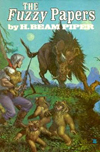
After 1964, H. Beam Piper's fiction fell into the limbo that exists for writers who are popular during their lifetimes, but whose stories disappear after their deaths. Any publisher who might want to reprint one of Piper's books had to do some detective work to find out whom to contact to get the rights. Anybody who wanted to read Little Fuzzy or The Other Human Race had to find the fragile Avon paperbacks. By the mid-1970s, SF specialty bookshops were selling ratty copies of Little Fuzzy (originally 40¢) for $10.00 or more to fans who just wanted to read it, not as a collectible investment.
Finally, in the mid-1970s, Ace Books began to reissue Piper's stories, later buying Piper's whole literary estate for what was described as "a small sum" ($1,000, according to Jerry Pournelle). This included the right to reprint all his stories, and to commission new sequels to any of them. Ace also licensed the Science Fiction Book Club to publish a collected hardcover volume of Piper's two Fuzzy novels, under the title of The Fuzzy Papers.

One of the first novels to reappear was Little Fuzzy, in January 1976. Ace had arranged with a new artist who had just graduated from art college, Michael Whelan, to paint its cover, and the covers of all following Fuzzy editions. Whelan, just beginning his Hugo Award winning career, was the perfect choice. His depiction of the Fuzzies immediately became the standard model for them ever since. (Although the original, considerably different depiction by Victor Kalin on Avon's 1962 paperback was also very attractive and was equally accurate to Piper's description).
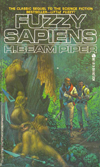
Ace followed Little Fuzzy with the sequel in June 1976, with its title restored to Piper's preferred Fuzzy Sapiens. This set off a minor controversy in fandom as to what the "real" title of the second novel should be. This is a chicken-or-egg philosophical debate that can never be definitively settled since it is a matter of opinion. Some say that a book's actual title should be what it is first published under. Earlier, tentative working titles do not count, since an author may consider dozens of titles before finally picking one. Others claim that this does not apply here, since Piper had made it clear that Fuzzy Sapiens was always his chosen title, and that he had not liked The Other Human Race. Nevertheless, since 1977, the second Fuzzy novel has been republished as both Fuzzy Sapiens and as The Other Human Race, with both versions claimed as the original title. The Other Human Race was used in the SFBC's The Fuzzy Papers collection, which quickly became the one-volume Fuzzy Bible for fans as soon as it appeared in February 1977.
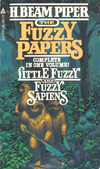
Piper's other novels reappeared in a series of new paperbacks from Ace Books during the late 1970s, followed by new collections of his short stories in the early 1980s. Fans were frustrated that this set would not include the legendary third Fuzzy novel. Even if it had been lost or never finished, the fact that Piper had said that he was writing one showed that the Fuzzies' story had not been finished.
Ace was already on top of this situation. A news report in Science Fiction Review #27, September-October 1978, read: "H. Beam Piper's estate is now being handled under the auspices of Jerry E. Pournelle who is cooperating with Ace to bring out new books based on Piper's literary corpus. William Tuning, a frequent contributor to ANALOG, is writing the third novel in the popular Fuzzy series."
Bill Tuning was a well-known fan and a beginning short-story writer during the 1970s. He was a veteran SF convention attendee, often working as a Security volunteer in his costume of a galactic mercenary. He was an enthusiast of military-action SF, which included much of Piper's writing. (He also shared Piper's propensity for hard drinking). Tuning was negotiating with Ace Books to sell them his first SF novel (Tornado Alley; it was published in December 1978), when Ace began the Piper Publication Project with much enthusiasm. Tuning wanted to get in on it. He proposed that Ace should assign him to write the sequel to Lord Kalvan of Otherwhen, Piper's most serious military-action novel. However, Ace's interest at that moment was in a Fuzzy sequel. That was fine with Tuning; he'd enjoyed the two Fuzzy books, too.
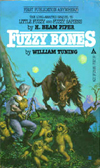
Tuning took his time to make his Fuzzy novel, Fuzzy Bones, as good as he possibly could. Fuzzy Bones was not published until December 1981. Piper's fans were generally pleased with it. The consensus was that the writing wasn't quite up to Piper's standard, but it was clearly a devoted tribute rather than hackwork. And it ended on a cliffhanger, promising more to come.
Tuning took a background villain from the second novel, Hugo Ingermann, and built him into a major threat. Piper had introduced Ingermann in Fuzzy Sapiens as a shyster lawyer who was "probably" connected to most of the crime on Zarathustra. When Fuzzies were kidnapped to be trained for crime, everyone assumed that Ingermann was behind it somehow. He turned out to be a red-herring villain who was actually innocent, for once – though the novel ended with an offhand comment that the intense crimehunt for the real villains had incidentally uncovered enough evidence of Ingermann's shady dealings to get him disbarred and socially ruin him. Tuning postulated that, after his disbarment, Ingermann turned his talent for smooth courtroom oratory into rabble-rousing demagoguery among Zarathustra's lower classes, scheming to dominate the planet's new political scene – and plotting to use the Fuzzies in his rise to power.
There was one big controversy, however. In a major subplot, Tuning had the humans dramatically discover that the Fuzzies were not native to Zarathustra – they were the degenerated descendents of the survivors of a crashed spaceship from an unknown interstellar race! Tuning explained that he felt that this was a better explanation for the Fuzzies' biological incompatibility to Zarathustra's ecology, as described in the second novel. The fans' reaction to this development was mixed. Tuning made a well-reasoned argument, and it did not actually contradict Piper's picture of the Fuzzies and of Zarathustra. But some felt that it was exaggeratedly melodramatic, and less plausible than Piper's concept of slow extinction due to natural planetary evolution.
On the whole, though, Fuzzy Bones was a success. It turned what had been one popular novel and its sequel into a new series. Tuning was interviewed on Los Angeles's popular radio SF talk show, Hour 25, where he announced that he had already begun plotting the fourth Fuzzy novel, to be titled Captain Fuzzy. But then he unexpectedly died, on April 18, 1982. His obituary, in the June 1982 issue of Locus, stated that he had died "of blood disease contracted during a hospital stay for the treatment of alcoholism". Captain Fuzzy never materialized.
Ace Books did not want to lose the momentum started by its third Fuzzy novel, however. A different novel had already been proposed by another Ace writer who was an enthusiastic Fuzzy fan, Ardath Mayhar. She had been around the Ace offices negotiating on novels of her own during this period of Piper Publication enthusiasm, and had gotten an advance look at Tuning's sequel. She proposed a story which would elaborate on the origins and history of the Fuzzies, without conflicting with Tuning's role as author of the Fuzzies' current adventures. After Tuning’s death, Ace accepted her proposal to keep the "Fuzzy market" active while considering whether to get someone else to complete Captain Fuzzy. Mayhar's Golden Dream: A Fuzzy Odyssey was published in October 1982 with major promotion as a large $5.95 trade paperback (at a time when Ace's regular paperback price was $2.50).
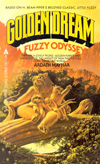
Golden Dream ignored the current political situation on Zarathustra. Instead, it explored Tuning's revelation that the Fuzzies were stranded aliens, not natives. The novel was divided into two halves. The first half described the disaster that marooned a spaceship on Zarathustra in the distant past, forcing its survivors to become colonists. In episodic scenes showing generations passing, the Fuzzies were forced to give up their failing colony near the remains of their starship. They became nomadic hunters and gatherers, gradually dwindling as they moved further from the site of their buried starship. (Unknown to them, trace metals from their ship were genetically necessary for their fertility). The final, longest sequence starred a Fuzzy who was gradually revealed to be Little Fuzzy himself, and the story was a replay of the meeting of humans and Fuzzies in Little Fuzzy from the Fuzzies' point of view.
Golden Dream was received by the Fuzzy fans as okay. It was actually received almost as an afterthought, because the same month that it was released came the news that Piper's missing Fuzzies and Other People had finally turned up! The news was best summarized in Locus, October 1982, under the headline "Lost Fuzzy Novel Found".
Much of the background information from that story has been cited earlier in this article. Ace Books had been publishing all of Piper's novels and short stories since late 1975; by 1982 they had been used up. (The final book, a short-story collection edited by John F. Carr titled The Worlds of H. Beam Piper, appeared in January 1983). Ace's editor, Beth Meacham, had contacted Michael Knerr, Piper's friend who had all of his notebooks and records, to find out whether there was anything worthwhile left in them. Knerr hadn't thought so, but he made one last check in July, and discovered what appeared to be an unopened box of typewriter paper at the bottom of a trunk in the basement. It contained a carbon copy of the Fuzzies and Other People manuscript. Locus quoted Knerr as apologizing profusely to all of Piper's fans that he had dismissed as wishful dreamers for insisting that the book had really existed. The report ended by announcing that Ace would publish the novel in Fall 1983.
Naturally, nobody was very interested in further Fuzzy novels by other writers until Fuzzies and Other People came out. Should it be considered the third or the sixth book in the series? Would it contain anything that might conflict with Tuning's "news" that the Fuzzies were not native to Zarathustra?
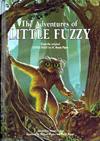
For the record, there was one more Fuzzy book that nobody was talking about, because almost nobody knew that it existed. In January 1983 a 43-page children's picture book version of Little Fuzzy appeared under the Platt and Munk Publishers imprint. (Ace Books had become a subsidiary in 1972 of Grosset and Dunlap, which owned Platt and Munk as another subsidiary). The Adventures of Little Fuzzy, from the original Little Fuzzy by H. Beam Piper, adapted by Benson Parker, was a large-format (29 cm.) picture book with colored illustrations on every page. Unlike the Fuzzy novels published by Ace Books, this was given no publicity. The few fans that discovered this book reported that it was disappointing. The credits read "Illustrated by Michael Whelan and David Wenzel", but Whelan's art was limited to the cover painting; all the interior art was by Wenzel and was notably inferior. Parker's version of the story, as narrated by Little Fuzzy, made the Fuzzies too obviously intelligent too soon. The general opinion was that The Adventures of Little Fuzzy was only worthwhile for Whelan's cover art, or for Fuzzy completist collectors.
Ace Books did not actually publish Piper's last novel until August 1984. It turned out to be a real shocker! The question of the Fuzzies' origin turned out to be almost incidental; Fuzzies and Other People directly contradicted the basic plot of Fuzzy Bones.
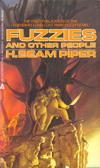
Piper had ended Fuzzy Sapiens with a comment that the Fuzzy slavers would be tried and without doubt convicted; that the crime carried a mandatory death sentence; and that Hugo Ingermann was certain to be disbarred. Tuning had opened Fuzzy Bones several months later, with a comment that the criminals had duly been convicted and executed and Ingermann had been disbarred, but that he had just moved from the legal circuit into the political arena. But Fuzzies and Other People took place immediately after Fuzzy Sapiens, and the trial of the Fuzzy slavers was its main plot – with a not-yet-disbarred Hugo Ingermann as the criminals' defense attorney. The novel ended with the slavers convicted but (due to the events in the story) getting life imprisonment rather than being executed; and with Ingermann fleeing Zarathustra to escape arrest when positive evidence of his crimes was about to be revealed. With Ingermann permanently gone, none of the main events in Fuzzy Bones could have taken place. Also, while nothing in Fuzzies and Other People actually contradicted Tuning's postulate that the Fuzzies had originated off-planet, the additional detail which Piper supplied about the ecological niche and living conditions of wild Fuzzies made it clearly unlikely that Piper had ever considered them to be anything other than a part of Zarathustra's own evolution.
This development undercut most of the interest in a continuation of Tuning's ideas. Fuzzies and Other People had its own suggestion for another sequel, with an offhand comment on the final page that the new Zarathustra government needed a representative to the Terran Federation headquarters on Earth. Jack Holloway was its choice, at least provisionally; and Holloway was idly wondering whether he should take Little Fuzzy to see Earth. But this was not followed up. Ace had finally decided to commission Great Kings' War, the sequel to Piper's Lord Kalvan of Otherwhen in his Paratime series, by Roland Green and John Carr. That was published in February 1985. After that, the whole concept of new sequels to Piper's series seemed passé.
Jerry Pournelle, who was one of Piper's best friends and a past president of the Science Fiction Writers of America, says that it's a tricky situation when new writers continue a famous author's stories. There are always some fans that complain that the sequels aren't as good – which is often true, since the new writers are invariably new writers, not as skilled as the famous authors. Most writers with any talent would rather create and develop their own ideas than live in another author's worlds. The "shared world" concept is practical only when there is a strong financial incentive to continue an already established series. There was not much potential money in new Piper sequels. Devoted young fans may write worthwhile sequels due to raw talent and an enthusiasm that comes close to living in that story's world. This is how some of the best Star Trek or Conan novels have come to be written. William Tuning had been almost unique in feeling that way about the Fuzzy universe. There were other Fuzzy fans, but none who were dying to write their own Fuzzy stories. Also, the broad discrepancy that had developed between Piper's and Tuning's Fuzzy worldview showed that even devotion was no guarantee that another writer would automatically be faithful to Piper's ideas. Pournelle said that Piper himself had been focusing completely on Lord Kalvan of Otherwhen and at least a couple of planned sequels to it at the time of his suicide; and that there were gaps in his Terran Federation/Galactic Empire future history that he intended to fill. He may have deliberately left an opening for further Fuzzy stories in case it became profitable to write them, but he had no specific plots that he wanted to tell – there were no more Fuzzy sequels "crying to be told".

It would be inaccurate to say that interest in the Fuzzy novels faded away at this point. Piper's three novels have met the practical definition of classics; they have continued to sell well enough that they are periodically reprinted by Ace Books every few years. The Tuning and Mayhar novels, on the other hand, have been allowed to go out of print – ironically, their novels rather than the Fuzzies have proven to be the unsuccessful evolutionary offshoot.
The consensus today is that the Fuzzies' story has been told, and that additional guesses as to "what happened next" would be superfluous. If there is any interest today among Piper fans in continuing his writings, it is in finishing his Lord Kalvan story (the sequel by Green and Carr carried it further but ended with much still to be told). A $15.00 trade paperback single volume of all three of Piper's Fuzzy novels, The Complete Fuzzy, replaced the out-of-print The Fuzzy Papers in December 1998. The three novels are available from most good SF specialty bookshops, when they are not generally available due to a fresh reprint from Ace Books. Read them and enjoy them.
Afterword
Several years later, John F. Carr wrote a profile of Piper's last days, "The Last Cavalier: H. Beam Piper" (Analog SF, January 1988). It contained new information that corrected several aspects of "what everybody knew" at the time. For starters, Little Fuzzy had not been as brand-new as Piper had implied when he told his fans in 1961 that he had just sold it to Avon. John W. Campbell had rejected it as a serial for Astounding/Analog in May 1959. More importantly, it had been discovered that Piper had been more proud and secretive than even his friends had realized and had deliberately manipulated his own public image. The story of being poor because his ex-wife had taken everything in a divorce was the reverse of the truth. Piper had always been poor, and his wife had had much more money than he had. After they were divorced, he was cut off from her assets. Other examples of his pride helped to explain why he refused to ask for help, yet could not bear to become publicly revealed as destitute. Piper's suicide was discovered by the Pennsylvania State Police on Monday, November 8, 1964, not the 9th or 11th; he had shot himself either the previous Saturday or Sunday.
I would like to thank Jerry Pournelle and John F. Carr for personally helping with this article. Carr commented that Piper's secretiveness was apparently life-long, because even close friends during his school days were given different answers as to what his first name "really" was. Awareness of Piper's twisting of his self-image would explain why his close friend, Michael Knerr, was so ready to assume that Piper had not really written Fuzzies and Other People when no manuscript could be found, despite the assurances of several of Piper's correspondents that he had told them that it was completed.
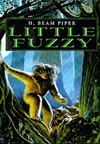
2011 addendum: In 2006 Wikipedia added a weblink to its entry on H. Beam Piper from the Find a Grave website (dated May 2003) showing a photograph of his gravestone at his birthplace, Altoona, Pennsylvania, reading "Henry Beam Piper, 1903 – 1964", settling the debate over his first name. In May 2008 John F. Carr's H. Beam Piper: A Biography was published, confirming Piper's first name and based upon Piper's own diaries from the mid-1950s to his death. They revealed that not only had Astounding rejected Little Fuzzy in 1959, Piper's agent Ken White then submitted the manuscript over the next two years to just about every publisher then publishing science fiction, including Avon, and they all rejected it! It was not until Avon hired a new SF editor in 1961, Janet Wood, that it sold. Wood had asked White if he had any good SF manuscripts available, White resubmitted Little Fuzzy, and Wood loved it. Wood even envisioned Fuzzy movie and merchandising sales, but Avon let her go in 1963 and her only legacy that materialized were the two sequels that she had authorized Piper to write.
Piper's fans during the 2000s created many Fuzzy websites. More recent reviewers have noted that Piper's descriptions of 1950s technology and social conventions stand out as outdated today: men tend to be executives while women are secretaries; people develop photographic film, play LP phonograph records, and smoke heavily.
In early 2006 Ace Books allowed the copyrights on Little Fuzzy and many other Piper works (but not Fuzzy Sapiens or Fuzzies and Other People) to expire. Unauthorized public domain editions of Little Fuzzy immediately began to appear, proving that despite its outdated sociology, the story was still very popular. Little Fuzzy was posted on the Project Gutenberg website in April 2006, with a statement that it is out of copyright and in the public domain in the United States. Wildside Press published a new paperback edition of Little Fuzzy in October 2006, citing its public domain status. A six-hour audio CD edition, read by Brian Holsopple, was released by Wildside's AudioRealms division the same month. By 2011 Amazon.com listed almost a dozen editions of Little Fuzzy, either by itself or in collections of some of Piper's other public domain works, in paperback or Kindle editions.
Also in 2011, two new Fuzzy novels were published! Fuzzy Ergo Sum, by Wolfgang Diehr, was a "fourth" story, a direct sequel to Piper's three novels. Diehr was a Piper fan who moderated the Piper Worlds online discussion group, and he had written the novel over several years with the editorial input of John F. Carr, the leading Piper scholar. Carr liked the story enough that he published it in hardcover in March 2011 at his Pequod Press, with an attractive wraparound dust jacket by Alan Gutierrez showing the Fuzzy appearance that Michael Whelan had established. Since Piper had brought the Fuzzy story to a conclusion, Diehr introduced several new subplots to start a new adventure. He created a backstory for Jack Holloway and some other established characters, added new characters, and expanded on the Fuzzy-human relationship. The most colorful addition was the establishment of the Fuzzy dog riders, a corps of Fuzzies riding a special breed of dogs bred for them. Diehr even reintroduced William Tuning's concept that the Fuzzies were not native to Zarathustra, in an intriguing new manner. Unlike Piper's novels, each of which were brought to a satisfying conclusion, Fuzzy Ergo Sum ends with a dramatic cliffhanger promising more of the story to come.
But three months later, Ace Books protested that Fuzzy Ergo Sum violated their copyright of Ardath Mayhar's 1982 Golden Dream: A Fuzzy Odyssey. Diehr had based his novel on the public domain Little Fuzzy, but he had included a few words of the Fuzzies' language that were created by Mayhar in her book. Diehr had asked for and gotten Mayhar's permission, but Golden Dream was copyrighted by Ace Books, not Mayhar, and Ace refused to give their okay. Diehr was forced to rewrite the pertinent passages to remove the copyrighted words, and Carr republished Fuzzy Ergo Sum with the changes (and a few typographical errors corrected) in a Second Edition, making the briefly-on-sale First Edition a collector's item.
Fuzzy Nation, by John Scalzi (Tor Books, May 2011), was meant by Scalzi as a tribute to and as a "reboot" of Piper's Little Fuzzy. Only the name of Jack Holloway and the basic plot are the same. Holloway, a lone, elderly, experienced prospector in Piper's novel, is here a young man with a dubious past, and an ex-girlfriend who works for the company. The fuzzies (lower case) are "cat things" (but the cover by Kekai Kotaki still shows Michael Whelan's character design) and not nearly as charismatic as Piper's Fuzzies. Zarathustra is not a planet but a megacompany on Earth, the Zarathustra Corporation (ZaraCorp), which "explores and exploits" many interstellar worlds; this one is "Zara XXIII". Fuzzy Nation is an enjoyable read, but it certainly has so many changes that it is hardly recognizable as the same story. More to the point, it is clever but not as "lovable" a story as Piper's. Readers will not care to know "what happens next" to the characters.
Where will The Fuzzy Story go from here? It seems that, almost fifty years after Little Fuzzy, the only sure thing is that there is more to come.